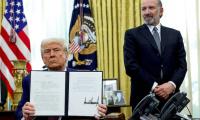KARACHI: As new information has come to fore about the circumstances in which the PIA flight PK 8303 crashed on Friday evening killing 98 passengers and crew, the air crash investigators are trying to figure if the tragedy was the result of pilot error or technical fault. It is believed that a report could be made public in three months. The new but preliminary report raises more questions as to what prevented the cockpit "could not inform the air traffic controllers of the emergency at hand. "
According to the Civil Aviation's preliminary report on Saturday, during the pilot's attempt to land the plane, the engines scarped the runway thrice causing friction and sparks. As a result three long plane friction marks were observed by the Civil Aviation's experts on the runway. According to sources, the engine abraded the ground first at around 4,500 feet, followed by second one on the right at 5,500 feet and at the third time the engine scrapped the ground at 7000 feet. But despite the scrapings the belly of the aircraft did at no point the touch the ground. It was from here that the pilot seemingly took off the aircraft. The officials and sources find it very strange that despite this the cockpit not once informed of any problem with the landing gear when it was abundantly clear that was an issue. They also find it difficult to digest that in any case of emergency there are automated emergency warning systems within the aircraft which no one can ignore. The system gives both shrill alarms and at the same time warns in words and it is not possible for the pilots to ignore.
Experts are of the view that perhaps during the three scrapings of the engine with the ground, the engine oil tank and the fuel pump were damaged and both the fuel and the engine oil began to leak from the aircraft which denied the pilot to achieve the thrust/speed and the required altitude of the aircraft leading to the ultimate crash.
As the pilot took off following the aborted landing attempt he tried to gain altitude of the plane. According to ATC and CAA sources, it was at this point the pilot "on his own" undertook to "go around" and it was only during this go around that the pilots informed that the landing gear were not opening.
After the lift off, he was directed by the air traffic controller (ATC) to take the air craft to 3000 feet but only managed to achieve 18,00 feet. When the cockpit was reminded to go for the 3000 feet, the first officer responded by saying"we are trying". This failure to achieve the directed height signifies that the engines were not responding. While approaching the runway from Malir designated as 25 L the pilots took a short distance of 1.5 nautical miles instead of mandatory 7 nautical miles defined for such a large sized plane. Failure to approach from the mandatory height and distance also raises the possibility that it happened as the engines did not provide enough thrust and speed to do both the functions it tilted and crashed suddenly. " The plane descended too fast, almost plunged," the sources familiar with the report said.
The investigators are battling with the idea as to why despite the visible problems they have found from the preliminary report, the pilots not once informed the air traffic controllers of any emergency, malfunction and engine failure or fire. They find it unpalatable. Similarly all the systems have automatic back ups and if one system fails another alternate takes over which also does not seem to have happened. They also seem to question the rarity of multiple technical problems which seems to have afflicted the ill fated plane.
Another evidence of the engine failure was proved by the deployment of Ram Air Turbine which only opens when the engines cease to function, sources said. However its functioning depends on plane's movement and speed to start the turbine which did not happen in this case despite its initial deployment.
The air traffic controllers conduct is also being looked into. During the entire time the plane's control remained with the senior Approach 'Radar' Air Traffic Controller who could not see the aircraft and not with the control tower who has the 'visual contact' with the plane. At this point it is being felt that this was so because of the cockpit's behaviour when they were told to maintain a certain higher altitude to which they responded they would manage but could not do so. It is probable after this that the senior Approach 'Radar' Air Traffic Controller decided to control the aircraft
Based on the very preliminary some sketchy and vague assumptions are being drawn that if the plane had been allowed by the air traffic controller in visual contact with the plane not to take off for "Go Round" and land anyway when the engines had abraded the runway, it would have only overshot into the Kutcha track outside the runway and stopped in the lose mud. Though it is always possible that the pilot would have decided against it.
At this points there are more questions then answers, most serious what and how the alarm systems inside the cockpit failed to warn the pilots of the emergency.
Our correspondent adds from Karachi:
The Federal Aviation Minister Ghulam Sarwar Khan has said that government will compensate for the damage to private property following the crash of PIA aircraft on Friday afternoon. He said he and the PIA CEO would quit and offer themselves for accountability if the inquiry report holds them responsible for any oversight or laxity.
The aviation minister stated this on Saturday as he visited the site of the plane crash in Model Colony area and supervised the aid work being carried out there. Khan announced that each of the bereaved family of the passengers who had lost their lives in the air crash would be given Rs one million as compensation by the government and the injured will be given Rs 500,000 each. Besides, the amount of compensation to the victims of air crash due to the insurance claims would be around Rs five million and the government would try its best to get it paid at the earliest to the affected families.
The minister said the government would also bear the expenses to be borne on repair and restoration of the houses damaged in the crash. He said that similarly, the government would compensate the damage to the motor vehicles on the ground.
The aviation minister said that the pilot of the fateful PIA aircraft had done all in his power to avoid the crash and minimize the life losses. He said the pilot did his best to bring the aircraft to the runway. But when he (the pilot) realised it was difficult then he did his best to minimise the damage on ground. He said that two passengers had survived the air crash as rest all on board the aircraft including the pilots and crew had lost their lives in the incident.
Khan said that prime minister has issued serious directions to the relevant authorities to conduct a transparent inquiry into the tragedy which they would make public and try to conclude that at the earliest. He said the concerned aviation experts could give their opinion to the investigation team. He said that the investigation process would be completely independent and transparent.If in case the minister concerned and chief executive officer (of the PIA) were found responsible then both will resign and present them for accountability, he said.
He said that senior and qualified officers of Pakistan Air Force have been made part of the inquiry board to conduct the probe independently. He said that the probe would be a serious institutionalized effort. Besides, the Airbus would also conduct its own probe into the crash and for that purpose the air crash experts from Germany and France would visit Pakistan. Khan advised people to avoid speculating till the time the exact causes of the tragedy were determined. He said the speculations would hurt the sentiments of the bereaved families and other victims of the air crash. The aviation minister said that he would not hesitate from resigning if it was determined that his own slackness was the cause behind the air crash.
He said the investigation report about the crash would be made public and will also be presented before the parliament. He offered his heartfelt condolences with the heirs of the crash victims, the PIA employees, the Pakistani brethren in general and the citizens of Karachi for the calamitous tragedy. The minister appreciated the emergency rescue work carried out at the air crash site by volunteers of the private charities.
Khan said that the foremost priority of the government was handing over the bodies of the victims of the air crash to the bereaved families after a thorough identification through DNA sampling. Then the second most important priority of the government is to provide compensation to the victim families. Lastly, the government has to pay compensation to the people whose private property including houses and vehicles had been damaged due to the incident.
He said that it was the government’s responsibility to compensate such damage on the ground. He said a rescue team of National Disaster Management Authority had reached Karachi from Lahore and was taking part in the emergency work at the crash site.
Number of Russian air attacks is increasing which proved that pressure on Russia is still insufficient, Zelensky said
Trump sent letter to Iran’s supreme leader last month calling for negotiations but warning of military action if...
Dhaka’s interim authorities are seeking US diplomatic support
Fatemi believes Pakistan will have to articulate and evolve its strategy in exceptionally careful manner
US must consider real-world implications of these measures rather than relying on general assumptions
New world will be governed less by established rules and “more by deals and alliances,” added Starmer







